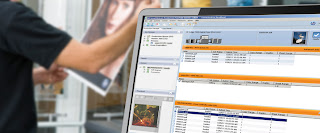So it's kind of fascinating that today, there is a workflow renaissance going on. It's really interesting because it's primarily driven by print service provider needs that focus on making vendor equipment more efficient. These demands have always been present, but because they didn't gate the hardware sale for the press maker, nor did satisfying them differentiate a particular vendor company from its competition, they were not top of mind for anyone.
That has changed, for a number of reasons.
First, Web-To-Print is maturing, and many more PSPs need super efficient workflows to handle the high volume of extremely short run work. Second, presses are bigger and faster, as well as more expensive. So PSPs ramp up sales efforts to increase equipment utilization, to pay the press bills. To make money, labor expenses (and as a result, craft), must be kept at a minimum and workflow software is the only answer.
The demands from PSPs are frankly greater than what most vendors are delivering. With some great exceptions, many of the workflow solutions in the market today can be considered "legacy software".
Two of the brightest exceptions today are HP SmartStream Production Center, and Enfocus' Switch line of products, which we aren't going to go into in detail here, but may in a future post.
Two of the brightest exceptions today are HP SmartStream Production Center, and Enfocus' Switch line of products, which we aren't going to go into in detail here, but may in a future post.
Instead, for the moment, let's think about some of the things vendors need to address to take workflow to the next level, and satisfy the emerging requirements of PSPs for the next few years. I'm probably going to write some discrete posts on some of these topics in the future, too.
- Sell software standalone vs. bundling with hardware.
- Make workflow software work well with other people's equipment, including competitor equipment.
- Package and describe workflow software in bite size pieces that directly address the MOST IMPORTANT customer/users needs directly.
- Make the existing software modern with user interface enhancements. Software that runs on Windows will soon benefit from the "Metro" interface. Some of the interfaces of industry software just look horrible, and users have become accustomed to new, beautiful web interfaces they use in their life outside of work.
- Make workflow a sexy part of the print production story, with giant screens, visualization and data elements, ala Landa and HP Production Center.
- One of the coolest things about the Landa launch was the Tablet device from which the operator could control 3 presses
- Appropriate parts of Workflow software should run in browsers, and even smartphones. Handheld devices are incredibly valuable for managing a large and busy production floor. They are good for a small and busy production floor, too.
- Touchscreens everywhere appropriate. Command line interfaces are still important for the tech nerds, though.
- Rule based automation should be defined either graphically, or by writing code, depending on how complex the rules, and how sophisticated the user.
- Run the workflow software in the Cloud, delivering it as a set of services at tiered monthly subscription fees. If Adobe can do it with Creative Suite, it can be done with workflow software, too.
- Larger customers today are far less concerned about whether something runs on a particular piece of hardware. Smaller customers would also likely gravitate toward the subscription model.
- Create better and more integration with MIS and Web-To-Print systems.
- Create better ways for customers to solve each other's problems and let customers enhance the software, ala Enfocus Crossroads-World community website.
- Add "cross-media" or marketing services stuff, where it directly benefits the PSP strategy to drive pages and profits.
- Help PSPs show how print complements email-- which for a younger audience with money to spend today is important (i.e., not how email or "cross media" complements print-- that's a message from yesterday.)
- Increasingly, the assets customers use to create printed materials are stored in the cloud. Workflow systems need to be able to reach into those systems (via APIs), and consume the assets to make print jobs.
In summary, we're talking about a whole new generation of print production workflow. It takes into account the new environment PSPs are operating in. It makes it so employees (especially those new to the industry) will want to become or stay involved in print production. It makes the company profitable, efficient and competitive. It remains to be seen whether this will be delivered by the existing vendors, or by the new vendors... but one thing is certain, it will happen!


No comments:
Post a Comment